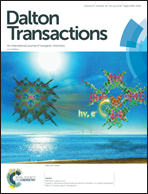Phosphorescence emission and fine structures observed respectively under ambient conditions and at ca. 55 K in a coordination polymer of lead(ii)-thiophenedicarboxylate†
Abstract
Under solvothermal conditions, a robust Pb2+-based coordination polymer (CP), [Pb(TDC)]n (1), where H2TDC is thiophenedicarboxylic acid, has been achieved. Structural analysis reveals that 1 crystallizes in the monoclinic space group C2/c, where the Pb2+ ions show quadrangular prism coordination geometry. CP 1 represents a 3D coordination network based on a TDC2− ligand as bridges and quadrangular prismatic PbO8 units as nodes, among which the PbO8 units are extended through edge-sharing to form a 2D layer in the bc plane. Interestingly, CP 1 emitted intense and long-lived orange phosphorescence in the solid state at room temperature, with a quantum yield of 6.7% and a phosphorescence lifetime of 1.78 ms. A fine structure is clearly observed in the phosphorescence emission spectra at temperatures below 55 K. The emission mainly arose from the electron transition within the π-type orbitals of the TDC2− ligand. This study gives a fresh impetus to achieve CP-based long-lived phosphorescent materials under ambient conditions.



 Please wait while we load your content...
Please wait while we load your content...